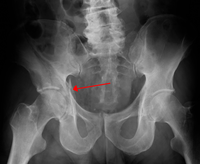
Photo from wikipedia
The purpose of the study is to evaluate the use of the suprapectineal quadrilateral surface (QLS) plates associated with the anterior intrapelvic approach (AIP) to the acetabulum in the surgical… Click to show full abstract
The purpose of the study is to evaluate the use of the suprapectineal quadrilateral surface (QLS) plates associated with the anterior intrapelvic approach (AIP) to the acetabulum in the surgical treatment of acetabular fractures with anterior involvement. We did a retrospective study of patients surgically treated with QLS plates and AIP for acetabular fractures with the involvement of the anterior column, between February 2018 and February 2020, in our Hospital. The following data were recorded: mechanism of injury, the pattern of fracture, presence of other associated injuries, the time before performing the surgery, surgical approach, position on operating table, time of surgery, intraoperative bleeding, hospitalization time, intraoperative and postoperative complications. Follow-ups were performed at 1, 3, 6, 12 months, then annually. The clinical-functional outcome was assessed with the Merle d’Aubigne Postel score (MAP) modified by Matta; while the radiological outcome with the Matta Radiological Scoring System (MRSS). A Chi-square test was utilized to examine associations between parametric variables. We included 34 patients, mean age 62.1, with an average follow-up of 20.7 months. The most frequent traumatic mechanism was road trauma. There were 15 isolated anterior columns and 19 associated patterns. There were 5 cases of associated visceral injuries, and 10 cases of other associated skeletal fractures. All patients were in the supine position. The surgical approach used was the AIP in all cases, with the addition of the first window of the ilioinguinal approach in 16 cases and of the Kocher-Langenbeck approach in 2 cases. The average time before performing the surgery was 8.5 days. The mean time of the surgery and the mean length of stay after surgery were 227.9 min and 8.2 days, respectively. There weren’t cases of intra-operative complications, while there were postoperative complications in 5 patients. The MRSS was judged anatomical in 26 cases, imperfect in 7 cases and poor in 1 case. The average MAP value was 15.2. We observed a significant relationship between the radiological outcome and the clinical outcome (p < 0.05). The QLS plates in association with the AIP approach represent an effective treatment strategy for the treatment of acetabular fractures with anterior involvement.
Journal Title: BMC Musculoskeletal Disorders
Year Published: 2021
Link to full text (if available)
Share on Social Media: Sign Up to like & get
recommendations!